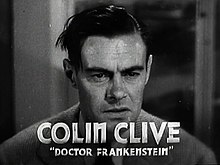Loading AI tools
English actor From Wikipedia, the free encyclopedia
Colin Glenn Clive (born Clive-Greig; 20 January 1900 – 25 June 1937) was a British theatre and film actor. He is most famous for his role as Dr. Henry Frankenstein in the 1931 film Frankenstein and its 1935 sequel, Bride of Frankenstein.
Colin Clive | |
|---|---|
 | |
| Born | Colin Glenn Clive-Greig 20 January 1900 Saint-Malo, Brittany, France |
| Died | 25 June 1937 (aged 37) Los Angeles, California, U.S. |
| Resting place | Ashes scattered at sea |
| Education | Stonyhurst College Royal Military Academy Sandhurst |
| Occupation | Actor |
| Years active | 1925–1937 |
| Spouses | |
Clive was born in Saint-Malo, France, to an English colonel, Colin Philip Greig, and his wife, Caroline Margaret Lugard Clive. He attended Stonyhurst College and subsequently the Royal Military College, Sandhurst, where an injured knee disqualified him from military service and contributed to his becoming a stage actor.[1] He was a member of the Hull Repertory Theatre Company for three years.[1]
Clive created the role of Steve Baker, the white husband of racially mixed Julie LaVerne, in the first London production of Show Boat; the production featured Cedric Hardwicke and Paul Robeson. Clive first worked with James Whale in the Savoy Theatre production of Journey's End and subsequently joined the British community in Hollywood, repeating his stage role in the film version.[2][3]
Clive's first screen role, in Journey's End (1930), was also directed by James Whale. Clive played the tormented alcoholic Captain Stanhope, a character that (much like Clive's other roles) mirrored his personal life. He was an in-demand leading man for several major film actresses of the era, including Katharine Hepburn, Bette Davis, Corinne Griffith, and Jean Arthur. He starred as Edward Rochester in the 1934 adaptation of Jane Eyre opposite Virginia Bruce. He was a descendant of Robert Clive and appeared in a featured role in Clive of India (1935), a biopic of his ancestor.[4][2]
Colin Clive, together with Leo G. Carroll, starred in a radio play titled The Other Place. It was written by John L. Balderston for the radio program The Fleischmann's Yeast Hour hosted by Rudy Vallee. It was aired on 14 November 1935.[5]
Clive was married to Jeanne de Casalis[6] in June 1929, though they were estranged for several years before his death.[citation needed]
Colin Clive suffered from severe chronic alcoholism and he died from complications of tuberculosis on 25 June 1937 at age 37.[4]
Clive's alcoholism was apparent to his co-stars, as he was often seen napping on set and sometimes was so intoxicated that he had to be held upright for over-the-shoulder shots. Clive was tormented by the medical threat of amputation of his long-damaged leg.[7]
Forrest J Ackerman recalled visiting Clive's body: "I actually saw him in death, lying in a bed at a mortuary where it was possible for the public to view his body. He looked remarkably as he had when lying in bed in The Bride of Frankenstein."[8] Over 300 mourners turned out. One of the pallbearers was Peter Lorre.[7] His cenotaph is located at Chapel of the Pines Crematory.

| Date of 1st performance | Title | Author(s) | City | Theatre | Role |
|---|---|---|---|---|---|
| 1925 March 20 | Rose-Marie | Otto Harbach, Rudolf Friml, Herbert Stothart | London | Drury Lane | Edward Hawley[12][13] |
| 1926 May 30 | Getting Mother Married | Neil Grant | London | Apollo | Capt. Eric Wilbraham[14] |
| 1927 June 30 | Fire | Arthur Rose | London | Everyman Theatre | St. John Sevening[15] |
| 1928 May 3 | Show Boat | Oscar Hammerstein II, Jerome Kern | London | Drury Lane | Steve[16][17] |
| 1928 November 4 | The Dark Path | Evan John | London | Savoy Theatre | James Havilland[18] |
| 1929 January 21 | Journey's End | R. C. Sherriff | London | Savoy Theatre | Cpt. Stanhope[3] |
| 1929 April 14 | Let's Leave It At That | Jeanne de Casalis, Colin Clive | London | Prince of Wales's Theatre | Michael Stern[19][20] |
| 1929 April 23 | Shall We Join the Ladies? | J. M. Barrie | London | PalaceTheatre | Mr. Vaile[21] |
| 1930 February 2 | Forty-Seven | Sydney Loch | London | Prince of Wales's Theatre | Forty-Seven[22] |
| 1930 April 22 | Hamlet | William Shakespeare | London | Haymarket Theatre | Laertes[23] |
| 1930 June 30 | The Swan | Ferenc Molnár | London | St. James's Theatre | Dr. Nicholas Agi[24][25] |
| 1930 December 5 | Overture | William Bolitho | New York | Longacre Theatre | Karl Ritter[26] |
| 1931 May 21 | The Crime at Blossoms | Mordaunt Shairp | London | Playhouse Theatre | Christopher Merryman[27] |
| 1932 July 19 | Escape | John Galsworthy | London | Garrick Theatre | Matt Denant[28] |
| 1932 August 22 | Loyalties | John Galsworthy | London | Garrick Theatre | Ronald Dancy[29] |
| 1932 September 29 | Justice | John Galsworthy | London | Garrick Theatre | William Falder[30] |
| 1933 October 28 | Eight Bells | Percy G. Mandley | New York | Hudson Theatre | Dale[31] |
| 1933 December 26 | The Lake | Dorothy Massingham and Murray MacDonald | New York | Martin Beck Theatre | John Clayne[32] |
| 1935 December 20 | Libel | Edward Wooll | New York | Henry Miller's Theatre | Sir Mark Loddon, Bart. M.P.[33] |
Seamless Wikipedia browsing. On steroids.
Every time you click a link to Wikipedia, Wiktionary or Wikiquote in your browser's search results, it will show the modern Wikiwand interface.
Wikiwand extension is a five stars, simple, with minimum permission required to keep your browsing private, safe and transparent.